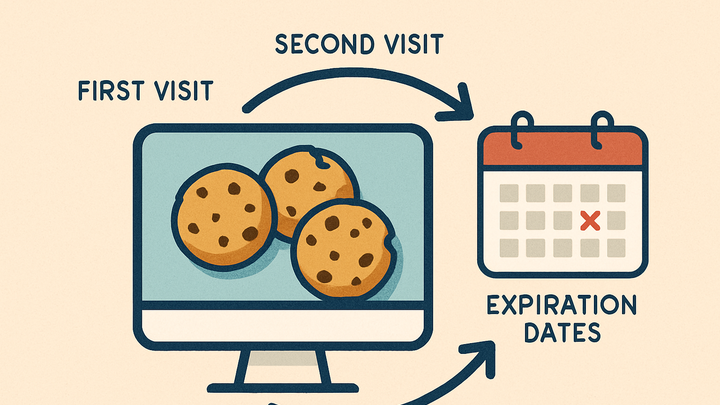Published on 2025-06-26T05:27:11Z
What Is a Persistent Cookie? Examples in Analytics
A persistent cookie is a small data file stored on a user’s device with a specified expiration date. Unlike session cookies, which are deleted when the browser closes, persistent cookies remain until they expire or are deleted by the user. They’re commonly used in web analytics to identify returning visitors, store user preferences, and enable customized experiences across sessions. By assigning a unique identifier, such as GA4’s _ga cookie, analytics platforms can track user journeys over time. However, privacy regulations like GDPR require transparency and user consent when deploying persistent cookies.
Persistent cookies
Persistent cookies store data on a user’s device beyond a single session, enabling return-visitor tracking and personalization.
How Persistent Cookies Work
Persistent cookies are created by servers via HTTP headers or client-side scripts. They include metadata like expiration dates, domain, path, and security attributes. Browsers store these cookies on disk and send them with matching requests until they expire or are deleted.
-
Creation and storage
When a user visits a site, the server sends a Set-Cookie header or JavaScript sets document.cookie. The browser saves the cookie with its metadata.
-
Set-cookie header
Servers issue an HTTP Set-Cookie header to instruct the browser to store a cookie.
-
Javascript api
Developers can set cookies client-side using document.cookie in JavaScript.
-
-
Expiration and deletion
Each cookie has an expiration timestamp. After this date, the browser automatically removes the cookie. Users can also clear cookies manually.
-
Expiration date
The Expires or Max-Age attribute defines how long the cookie persists.
-
Manual deletion
Users can delete cookies through browser privacy settings at any time.
-
-
Scope and security attributes
Attributes like Domain, Path, Secure, and SameSite control cookie scope and help mitigate security risks.
-
Domain and path
Define which URLs the cookie is sent to, limiting exposure.
-
Secure and httponly
Ensure cookies are transmitted over HTTPS and inaccessible to JavaScript when needed.
-
Benefits and Drawbacks of Persistent Cookies
Persistent cookies offer powerful capabilities for analytics and personalization but also introduce privacy and compliance considerations.
-
Benefits
Persistent cookies enable consistent user identification, personalized experiences, and more accurate analytics.
-
User recognition
Identify and remember returning visitors across sessions.
-
Analytics accuracy
Improve attribution and journey analysis by linking visits.
-
-
Drawbacks
Cookies can raise privacy concerns and must comply with regulations.
-
Privacy concerns
Users may feel tracked if cookies persist without consent.
-
Regulatory compliance
Laws like GDPR and CCPA require transparent disclosure and, often, explicit consent.
-
Examples in Analytics Platforms
Implementation of persistent cookies in mainstream analytics tools and a cookie-free alternative.
-
Google analytics 4
GA4 uses first-party persistent cookies (e.g., _ga) to recognize users across sessions. You can configure the cookie expiration via the
cookie_expiresparameter.-
GA4 cookie setup
<script async src='https://www.googletagmanager.com/gtag/js?id=G-XXXXXXX'></script> <script> window.dataLayer = window.dataLayer || []; function gtag(){dataLayer.push(arguments);} gtag('js', new Date()); gtag('config', 'G-XXXXXXX', { 'cookie_expires': 60*60*24*365 }); </script>
-
-
PlainSignal
PlainSignal is a cookie-free analytics platform. It does not rely on persistent cookies, instead using a lightweight tracking script that respects user privacy.
-
PlainSignal tracking code
<link rel='preconnect' href='//eu.plainsignal.com/' crossorigin /> <script defer data-do='yourwebsitedomain.com' data-id='0GQV1xmtzQQ' data-api='//eu.plainsignal.com' src='//cdn.plainsignal.com/plainsignal-min.js'></script>
-
Best Practices and Compliance
Apply responsible practices when deploying persistent cookies to respect user privacy and meet legal requirements.
-
Consent management
Obtain explicit user consent before setting persistent cookies, using banners or preference centers.
-
Consent banners
Display clear cookie notices and allow users to opt in or out.
-
-
Cookie policies
Maintain an accessible, clear cookie policy explaining types, purposes, and retention periods.
-
Transparent documentation
Detail each cookie’s name, purpose, and lifespan in your policy.
-
